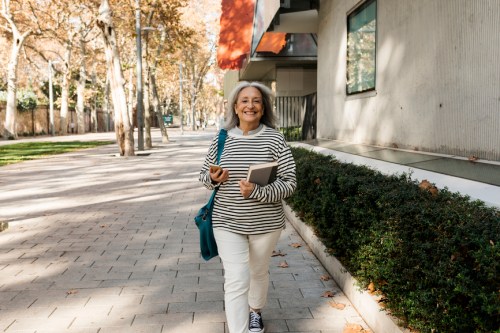Home to the world’s longest-living people, the five Blue Zones (including places like Sardinia, Italy, and Okinawa, Japan) are active case studies for how people can thrive as centenarians. Longevity expert and Blue Zones founder Dan Buettner previously identified a few longevity-boosting pillars these populations share—including regular movement and mostly plant-based diets. But in learning why these pillars tend to persist in these communities (and not in many others), he began developing the concept of the ‘life radius,’ which refers to the area within five miles of your home, where we live 80 to 90 percent of our lives.
Experts in This Article
Blue Zones expert and author of The Blue Zones Secrets for Longer Living
The particular design of that life radius, Buettner says, plays a major role in shaping your everyday habits, helping determine whether you’re likely to lead a long life (of course, alongside factors like your genetics, socioeconomic status, and personal interests). “While we had learned that people in Blue Zones regions were doing things like walking to their destinations whenever they’d leave the house, eating lots of plants, and surrounding themselves with networks of friends, the overarching thing we were searching for is, ‘What was keeping them doing these things long enough to avoid a chronic disease?’” says Buettner.
“The people who live the longest tend to live within environments where the healthy choice is the easy or even unavoidable choice.” —Dan Buettner, Blue Zones founder
The answer, he hypothesizes, lies mostly in the built environment and municipal policies of the areas where people spend most of their time, aka their life radius. “The people who live the longest tend to live within environments where the healthy choice is the easy or even unavoidable choice,” Buettner says. So while theoretically, anyone could try eating a plant-forward diet or working out in a gym, these activities often require money and significant effort on the part of the individual (consider the willpower it takes to stick to a new routine). But when your life radius is filled with walking paths and easy access to fruits and vegetables, for example, the barrier to entry for a healthy lifestyle drops, and longevity-promoting decisions become the default.
These positive environmental conditions have a lot of overlap with the social determinants of health, which are conditions of the places where you live, work, eat, and play. And these variables—including access to affordable food, health care, and housing, along with work and other components—factor into longevity because they directly impact health- and wellness-boosting components of life. It’s important to note that inequitable access to social determinants of health disproportionately affects Black, Indigenous, and people of color (BIPOC), generally increasing health disparities and decreasing longevity among these populations.
To help improve the life radius—and, by proxy, a number of social determinants of health—in U.S. cities with lower-than-average life expectancies (like Fort Worth, Texas, and Alberta Lea, Minnesota), Buettner and his team launched Blue Zones Project Communities, an ongoing initiative that sees out a variety of local policy and infrastructure changes in these cities.
Below, Buettner points out several life-radius adjustments in these cities that have proved successful for boosting longevity.
3 key components of a healthy life radius and how they contribute to longevity:
1. Transportation infrastructure that favors walking
When the streets in your neighborhood have bike lanes and wide sidewalks, you’ll simply be more apt to use those features than if the only way to get around is by driving. Those who travel by foot or bike are, in turn, taking active steps to boost their overall health and longevity.
With this in mind, transportation infrastructure requiring all new streets to have narrower lanes for driving (to make more space for pedestrians) can be an effective adjustment. Across the beach cities in California that were part of the Blue Zones Project, Buettner says 220 new miles of bike paths were installed along with safe routes for kids to walk to school, contributing to significant health improvements, including a 68 percent drop in childhood obesity rates at Redondo Beach K-5 schools between 2007 and 2019.
2. Food policies and programs that inspire healthy eating
Buettner points out that sugar-sweetened beverages are a leading source of refined sugar in Americans’ diets, which is why a couple of key food-related components of the Blue Zones Project are linked to policies around those beverages—namely, placing a moratorium on billboards that advertise them and even instituting taxes on soft drinks, as Philadelphia and Oakland, California both have.
Another major change: Adding more accessible ways for people to eat whole plants on the regular. In Albert Lea, Minnesota, for example, the Blue Zones Project expanded community gardening space by 150 percent, which, alongside changes implemented at local grocery stores, contributed to an overall increase in life expectancy for area residents by nearly three years.
3. Restrictions surrounding tobacco usage
It’s no secret that smoking tobacco can definitively compromise longevity, but Buettner and his team also found that the policies surrounding its sale and allowed usage have a strong effect on how many people within a particular life radius smoke it and how often they do so. In Albert Lea, for example, new policies restricting the use of tobacco at 507 units of public housing, 11 of the top 20 worksites, and a variety of outdoor parks, fairs, and sporting arenas led to a decline in smokers from 23 percent of adult residents in 2009 to 14.7 percent in 2016.
While not every city will be a Blue Zones Project, and thus not all will be subject to the funding and expert guidance that can improve your life radius, there are still plenty of ways you can take your longevity into your own hands. For example, you can adopt a version of the Mediterranean diet that works for you, cultivate healthy sleep habits, garden, and walk a little bit every day—no matter where you live.
Oh hi! You look like someone who loves free workouts, discounts for cult-fave wellness brands, and exclusive Well+Good content. Sign up for Well+, our online community of wellness insiders, and unlock your rewards instantly.
Sign Up for Our Daily Newsletter
Get all the latest in wellness, trends, food, fitness, beauty, and more delivered right to your inbox.
Got it, you've been added to our email list.











